Effects of Urban Growth on Architectural Heritage: The Case of Buddhist Monasteries in the Qinghai-Tibet Plateau
Abstract
:1. Introduction
2. Materials and Methods
2.1. Study Site
2.2. Data
2.3. Analytical Methods
2.3.1. Analysis of the Urbanization Level in the Q-T Plateau
2.3.2. Analysis of Urban Growth in Lhasa
3. Results
3.1. Urban Growth in the Q-T Plateau
- In 1993, there were 19 monasteries whose Un values were not 0. The seven monasteries with the highest Un values exceeding 0.5 were concentrated in Lhasa and Xining. The monasteries in other cities had low Un values, even Un values of 0.
- In 2003, the number of monasteries whose Un values were not 0 increased to 29. The monasteries with the highest Un values and largest increased Un values were still mainly concentrated in Lhasa. Also, the Un values of 10 monasteries were no longer 0; these were distributed in Shigatse (2), Shannan (2), Nyingchi (2), and Lhasa (1) in Tibet and Garze (3) in Sichuan.
- In 2013, there were 43 monasteries whose Un values were not 0. The Un values of most of the monasteries in Lhasa tend to be saturated (Un values close to 1). Compared to the period from 1993 to 2003, the monasteries with the largest increased Un values were now concentrated in Chamdo in Tibet and Garze and Ngawa in Sichuan, instead of Lhasa. Also, the Un values of 14 monasteries increased from 0; these were distributed in Shannan (5), Ngari (2), Shigaste (2), and Lhasa (1) in Tibet; Yushu (2) and Golog (1) in Qinghai; and Garze (1) in Sichuan.
- From a comprehensive analysis of the Un values between 1993 and 2013, it was found that the Un values of 43 monasteries increased, among which those of 24 monasteries grew from 0, whereas the Un values of 109 monasteries remained at 0. The areas that were significantly influenced by urban growth expanded from Lhasa to the Yarlung Tsangpo River, Nyangqu and Lhasa River regions, as well as the surrounding areas of Xining and Tibetan areas of Sichuan.
3.2. Urban Growth in Lhasa
4. Discussion
5. Conclusions
Author Contributions
Acknowledgments
Conflicts of Interest
References
- Urban Population (% of Total). Available online: https://data.worldbank.org/indicator/SP.URB.TOTL.IN.ZS (accessed on 2 January 2017).
- World Urbanization Prospects: The 2014 Revision, Highlights (ST/ESA/SER.A/352). Available online: http://esa.un.org/unpd/wup/Highlights/WUP2014-Highlights.pdf (accessed on 18 November 2016).
- Ciegis, R.; Ramanauskiene, J.; Martinkus, B. The concept of sustainable development and its use for sustainability scenarios. Eng. Econ. 2009, 2, 28–37. [Google Scholar]
- The Future We Want (A/RES/66/288). Available online: https://sustainabledevelopment.un.org/index.php?menu=1298 (accessed on 18 November 2016).
- Action Plan on Cultural Policies for Development. Available online: http://www.lacult.unesco.org/docc/1998_Action_Plan_Cultural_Policies_for_Dev_UNESCO.pdf (accessed on 21 April 2018).
- Report of the World Commission on Environment and Development: Our Common Future. Available online: http://www.un-documents.net/our-common-future.pdf (accessed on 21 May 2017).
- United Nations Conference on Environment & Development Agenda 21. Available online: https://sustainabledevelopment.un.org/content/documents/Agenda21.pdf (accessed on 21 May 2017).
- United Nations Millennium Declaration (A/RES/55/2). Available online: http://www.un.org/millennium/declaration/ares552e.htm (accessed on 25 May 2017).
- The Operational Guidelines for the Implementation of the World Heritage Convention. Available online: http://whc.unesco.org/en/guidelines/ (accessed on 10 February 2018).
- Girard, L.F.; Nijkamp, P. Cultural Tourism and Sustainable Local Development; Ashgate Publishing, Ltd.: Farnham, UK, 2009. [Google Scholar]
- Transforming Our World: The 2030 Agenda for Sustainable Development. Available online: http://www.un.org/ga/search/view_doc.asp?symbol=A/RES/70/1&Lang=E (accessed on 20 May 2017).
- The New Urban Agenda. Available online: http://habitat3.org/the-new-urban-agenda/ (accessed on 22 April 2018).
- People’s Republic of China, National Development and Reform Commission, Development and Planning Department. Urbanization Plan for 2014–2020. Available online: http://ghs.ndrc.gov.cn/zttp/xxczhjs/ghzc/201605/t20160505_800839.html (accessed on 20 May 2017).
- Council of Europe Framework Convention on the Value of Cultural Heritage for Society (Faro, 2005). Available online: https://www.coe.int/en/web/conventions/full-list/-/conventions/rms/0900001680083746 (accessed on 24 April 2018).
- National Bureau of Statistics of the People’s Republic of China. China Statistical Yearbook 2017. Available online: http://www.stats.gov.cn/tjsj/ndsj/2017/indexch.htm (accessed on 26 October 2017).
- Fang, C. The urbanization and urban development in China after the reform and opening-up. Econ. Geogr. 2009, 29, 19–25. [Google Scholar]
- National Bureau of Statistics of the People’s Republic of China. The Statistical Bulletin of the People’s Republic of China on National Economic and Social Development in 2017. Available online: http://www.stats.gov.cn/tjsj/zxfb/201802/t20180228_1585631.html (accessed on 2 March 2018).
- Li, Q. Urbanization Rate of Resident Population Will Reach 60% in 2020. Available online: http://www.xinhuanet.com/politics/2016lh/2016-03/05/c_128775510.htm (accessed on 16 May 2017).
- Fang, C.L.; Liu, X.L.; Lin, X.Q. Stages correction and regularity analysis of urbanization course of China. Arid Land Geogr. 2008, 31, 512–523. [Google Scholar]
- Zhou, G.Z. China’s urbanization should be possessed of ourselves characteristic. Urban Dev. Stud. 2006, 13, 13–14. [Google Scholar]
- Liang, B.W.; Luo, Z.F. Spatial pattern and convergence of the level of new urbanization in Chinese cities at prefecture-level in recent 10 years. Mod. Urban Res. 2017, 5, 67–74. [Google Scholar] [CrossRef]
- Fang, C.L.; Li, G.D. Analysis and recommendation on the particularity and gradual mode of new urbanization in Tibet. Bull. Chin. Acad. Sci. 2015, 3, 294–305. [Google Scholar]
- The Capacity of the Qing-Tibet Railway Continues to Increase, and the Passenger and Cargo Traffic Continues to Get to High Record. Available online: http://www.xinhuanet.com/local/2016-06/28/c_1119125357.htm (accessed on 21 May 2017).
- Brandi, C. Teoria Del Restauro; Edizioni di Storia e Letteratura: Roma, Italia, 1963. [Google Scholar]
- Feilden, B. Conservation of Historic Buildings; Routledge: London, UK, 2007. [Google Scholar]
- Munoz-Vinas, S. Contemporary Theory of Conservation; Routledge: London, UK, 2012. [Google Scholar]
- International Charter for the Conservation and Restoration of Monuments and Sites (The Venice Charter 1964). Available online: https://www.icomos.org/charters/venice_e.pdf (accessed on 17 June 2015).
- Recommendation Concerning the Safeguarding and Contemporary Role of Historic Areas. Available online: http://portal.unesco.org/en/ev.php-URL_ID=13133&URL_DO=DO_TOPIC&URL_SECTION=201.html (accessed on 11 December 2017).
- The Washington Charter: Charter on the Conservation of Historic Towns and Urban Areas. Available online: https://www.icomos.org/charters/towns_e.pdf (accessed on 15 December 2017).
- The Nara Document on Authenticity (1994). Available online: https://www.icomos.org/charters/nara-e.pdf (accessed on 17 June 2015).
- Charter on the Built Vernacular Heritage. Available online: https://www.icomos.org/images/DOCUMENTS/Charters/vernacular_e.pdf (accessed on 22 April 2018).
- Xi’an Declaration on the Conservation of the Setting of Heritage Structures, Sites and Areas. Available online: https://www.icomos.org/xian2005/xian-declaration.pdf (accessed on 16 December 2017).
- The Quebec Declaration on the Preservation of the Spirit of the Place. Available online: https://whc.unesco.org/uploads/activities/documents/activity-646-2.pdf (accessed on 22 April 2018).
- ICOMOS Charter on the Interpretation and Presentation of Cultural Heritage Sites. Available online: http://icip.icomos.org/downloads/ICOMOS_Interpretation_Charter_ENG_04_10_08.pdf (accessed on 22 April 2018).
- International Cultural Tourism Charter: Managing Tourism at Places of Heritage Significance. Available online: https://www.icomos.org/charters/tourism_e.pdf (accessed on 26 January 2018).
- The Valletta Principles for the Safeguarding and Management of Historic Cities, Towns and Urban Areas. Available online: https://www.icomos.org/Paris2011/GA2011_CIVVIH_text_EN_FR_final_20120110.pdf (accessed on 5 February 2018).
- Recommendation on the Historic Urban Landscape. Available online: https://whc.unesco.org/uploads/activities/documents/activity-638-98.pdf (accessed on 8 February 2018).
- Bandarin, F.; Van Oers, R. The Historic Urban Landscape: Managing Heritage in an Urban Century; John Wiley & Sons: Hoboken, NJ, USA, 2012. [Google Scholar]
- United Nations Education, Scientific and Cultural Organization, World Heritage Centre. Available online: http://whc.unesco.org/en/soc/?action=list&id_site=707 (accessed on 12 January 2017).
- Wang, Y.P. The Architecture Heritage in Lhasa; Southeast University Press: Nanjing, China, 2005. [Google Scholar]
- Chen, Y.D. Studies on Chinese Tibetan Architecture; China Architecture & Building Press: Beijing, China, 2007. [Google Scholar]
- Su, B. Archaeological Studies on Monasteries of the Tibetan Buddhism; Cultural Relics Press: Beijing, China, 1996. [Google Scholar]
- Pu, W.C. Tibetan Buddhist Monasteries of Gansu and Qinghai; Qinghai People’s Publishing House: Xining, China, 1990. [Google Scholar]
- Larsen, K.; Sinding-Larsen, A. The Lhasa Atlas: Traditional Tibetan Architecture and Townscape; Serindia Publications: Chicago, IL, USA, 2002. [Google Scholar]
- Zhang, Y.Y.; Sun, Z. Usability of architectural heritage surveying technologies in Tibet. Huazhong Archit. 2018, 36, 52–56. [Google Scholar]
- Ding, Y.; Zhang, J.P.; Wang, G.L. Application of 3D laser scanning technology in protection of Palcho Monastery. Tradit. Chin. Archit. Gard. 2010, 3, 24–28. [Google Scholar]
- Weng, Q. A remote sensing-GIS evaluation of urban expansion and its impact on surface temperature in the Zhujiang Delta, China. Int. J. Remote Sens. 2001, 22, 1999–2014. [Google Scholar] [CrossRef]
- Xiao, J.; Shen, Y.; Ge, J.; Tateishi, R.; Tang, C.; Liang, Y.; Huang, Z. Evaluating urban expansion and land use change in Shijiazhuang, China, by using GIS and remote sensing. Landsc. Urban Plan. 2006, 75, 69–80. [Google Scholar] [CrossRef]
- Liu, Z.; He, C.; Zhang, Q.; Huang, Q.; Yang, Y. Extracting the dynamics of urban expansion in China using DMSP-OLS nighttime light data from 1992 to 2008. Landsc. Urban Plan. 2012, 106, 62–72. [Google Scholar] [CrossRef]
- Peng, J.; Liu, Z.H.; Liu, Y.H.; Wu, J.S.; Han, Y.N. Trend analysis of vegetation dynamics in Qinghai-Tibet Plateau using Hurst exponent. Ecol. Indic. 2012, 14, 28–39. [Google Scholar] [CrossRef]
- Chen, B.X.; Zhang, X.Z.; Tao, J.; Wu, J.S.; Wang, J.S.; Shi, P.L.; Zhang, Y.J.; Yu, C.Q. The impact of climate change and anthropogenic activities on alpine grassland over the Qinghai-Tibet Plateau. Agric. For. Meteorol. 2014, 189, 11–18. [Google Scholar] [CrossRef]
- Lasaponara, R.; Murgante, B.; Elfadaly, A.; Qelichi, M.M.; Shahraki, S.Z.; Wafa, O.; Attia, W. Spatial open data for monitoring risks and preserving archaeological areas and landscape: Case studies at Kom el Shoqafa, Egypt and Shush, Iran. Sustainability 2017, 9, 572. [Google Scholar] [CrossRef]
- Agapiou, A.; Alexakis, D.D.; Lysandrou, V.; Sarris, A.; Cuca, B.; Themistocleous, K.; Hadjimitsis, D.G. Impact of urban sprawl to cultural heritage monuments: The case study of Paphos area in Cyprus. J. Cult. Herit. 2015, 16, 671–680. [Google Scholar] [CrossRef]
- Pappu, S.; Akhilesh, K.; Ravindranath, S.; Raj, U. Applications of satellite remote sensing for research and heritage management in Indian prehistory. J. Archaeol. Sci. 2010, 37, 2316–2331. [Google Scholar] [CrossRef]
- People’s Republic of China, Standing Committee of the National People’s Congress. Law of the Peoples’ Republic of China on the Protection of Cultural Relics (2017 Amendment). Available online: http://www.sach.gov.cn/art/2017/11/28/art_1034_121351.html (accessed on 10 December 2017).
- People’s Republic of China, State Council of the People’s Republic of China, State Administration of Cultural Heritage. List of National Key Cultural Relic Protection Units. Available online: http://www.sach.gov.cn/col/col1644/index.html (accessed on 11 December 2017).
- People’s Republic of China, State Bureau of Surveying and Mapping, National Catalogue Service for Geographic Information. 1:1 Million Basic National Geographic Database. Available online: http://www.webmap.cn/commres.do?method=result100W (accessed on 5 August 2017).
- Version 4 DMSP-OLS Nighttime Lights Time Series. Available online: https://ngdc.noaa.gov/eog/dmsp/downloadV4composites.html (accessed on 10 October 2016).
- Ma, T.; Zhou, C.; Pei, T.; Haynie, S.; Fan, J. Quantitative estimation of urbanization dynamics using time series of DMSP/OLS nighttime light data: A comparative case study from China’s cities. Remote Sens. Environ. 2012, 124, 99–107. [Google Scholar] [CrossRef]
- Lo, C.P. Urban indicators of China from radiance-calibrated digital DMSP-OLS nighttime images. Ann. Assoc. Am. Geogr. 2002, 92, 225–240. [Google Scholar] [CrossRef]
- USGS EarthExplorer. Available online: https://earthexplorer.usgs.gov/ (accessed on 16 October 2016).
- Chen, J.; Zhuo, L.; Shi, P.J.; Ichinose, T. The study on urbanization process in China based on DMSP/OLS data: Development of a light index for urbanization level estimation. J. Remote Sens. 2007, 7, 168–175. [Google Scholar]
- Zhuo, L.; Chen, J.; Shi, P.J.; Gu, Z.H.; Fan, Y.D.; Ichinose, T. Modeling population density of China in 1998 based on DMSP/OLS nighttime light image. Acta Geogr. Sin. 2005, 60, 266–276. [Google Scholar] [CrossRef]
- Li, D.R.; Yu, H.R.; Li, X. The spatial–temporal pattern analysis of city development in countries along the Belt and Road Initiative based on nighttime light data. Geomat. Inf. Sci. Wuhan Univers. 2017, 42, 711–720. [Google Scholar] [CrossRef]
- Pandey, B.; Zhang, Q.L.; Seto, K.C. Comparative evaluation of relative calibration methods for DMSP/OLS nighttime lights. Remote Sens. Environ. 2017, 195, 67–78. [Google Scholar] [CrossRef]
- Cao, Z.Y.; Wu, Z.F.; Kuang, Y.Q.; Huang, N.S. Correction of DMSP/OLS night-time light images and its application in China. Geoinf. Sci. 2015, 17, 1092–1102. [Google Scholar] [CrossRef]
- Small, C.; Pozzi, F.; Elvidge, C.D. Spatial analysis of global urban extent from DMSP-OLS night lights. Remote Sens. Environ. 2005, 96, 277–291. [Google Scholar] [CrossRef]
- Congedo, L. Semi-automatic classification plugin documentation. Release 2016, 4, 29. [Google Scholar] [CrossRef]
- Wang, Y.Y.; Li, J. Classification methods of land use/cover based on remote sensing technology. Remote Sens. Inf. 2004, 1, 53–59. [Google Scholar]
- Urban Overall Planning of Lhasa. Available online: http://www.gov.cn/zhengce/content/2017-08/08/content_5216625.htm (accessed on 10 January 2018).
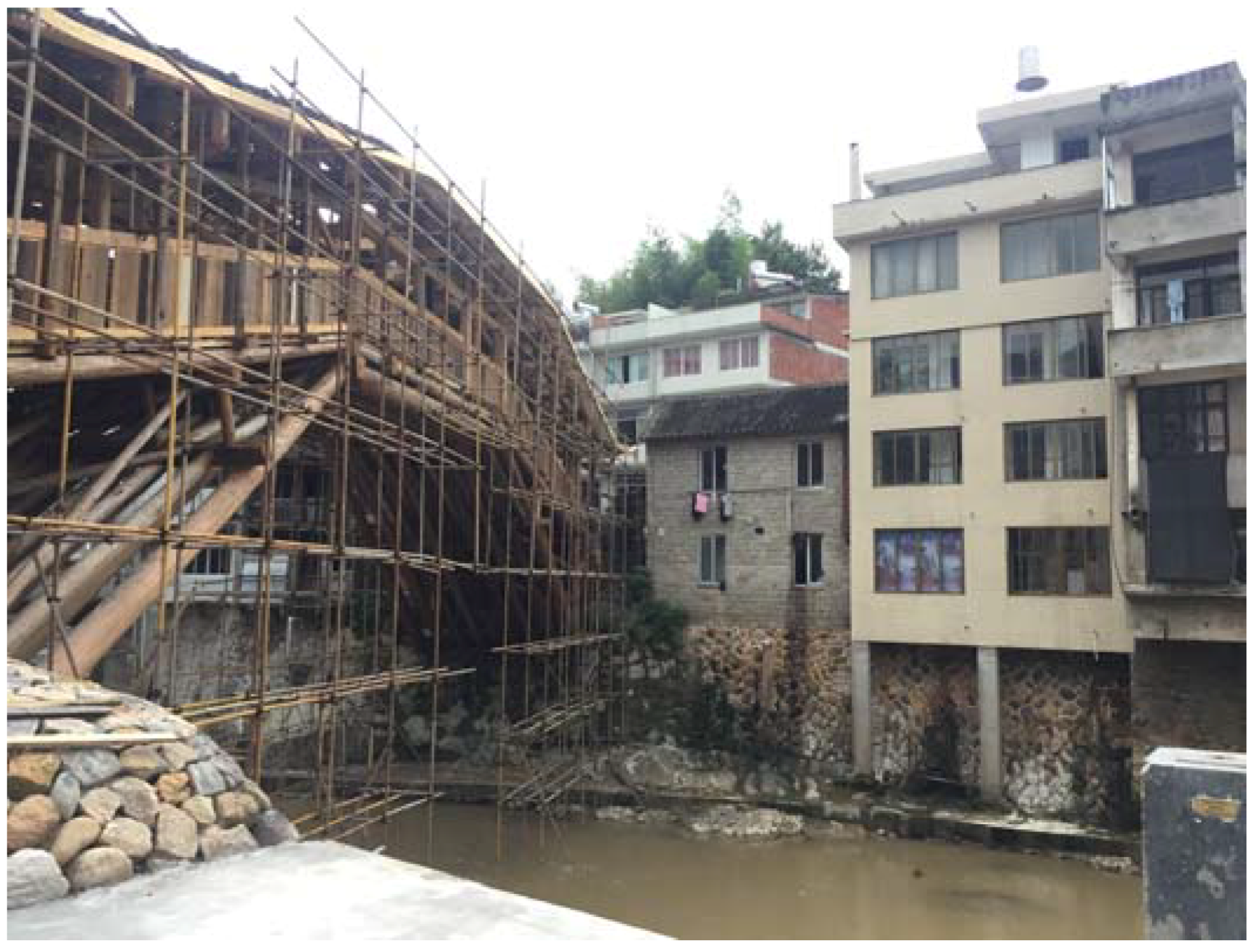
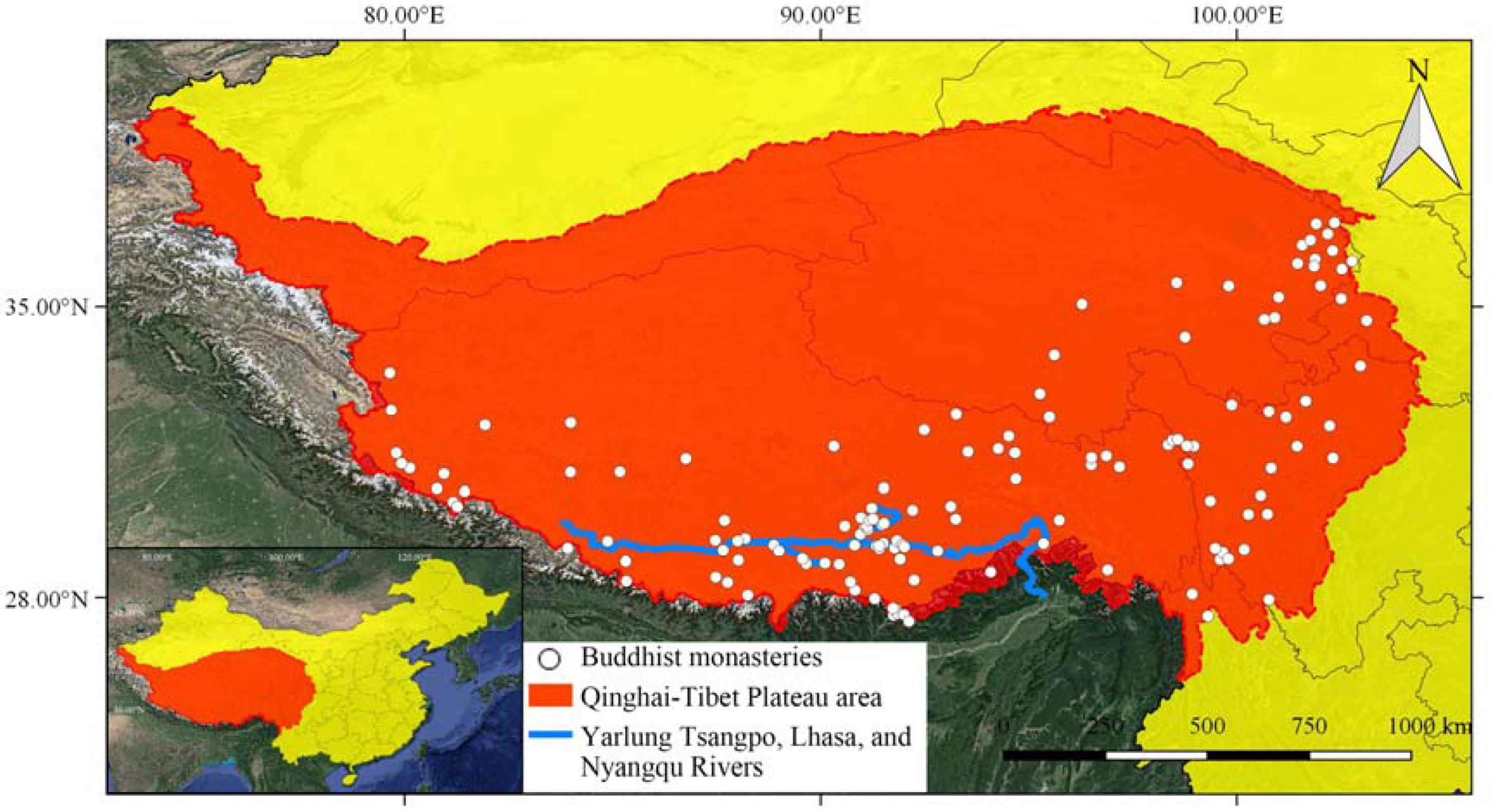
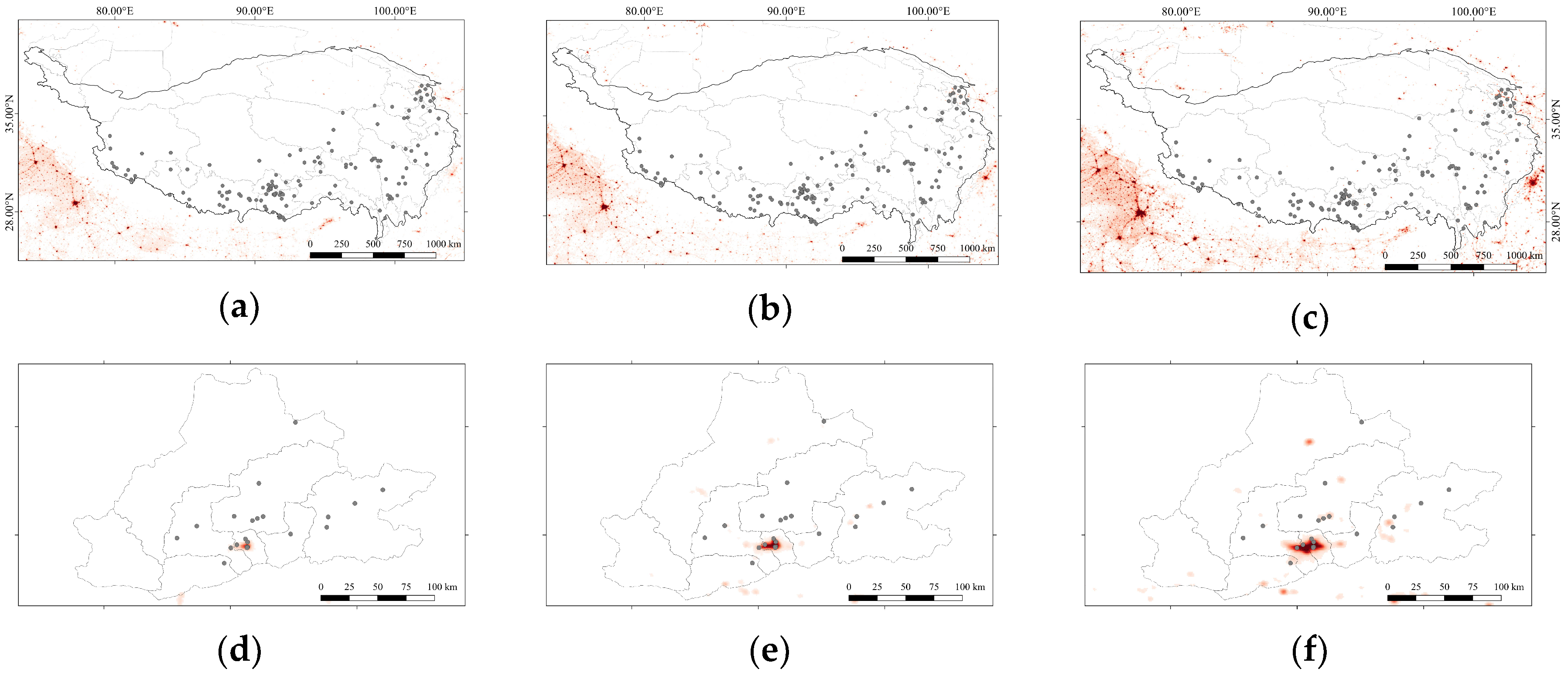
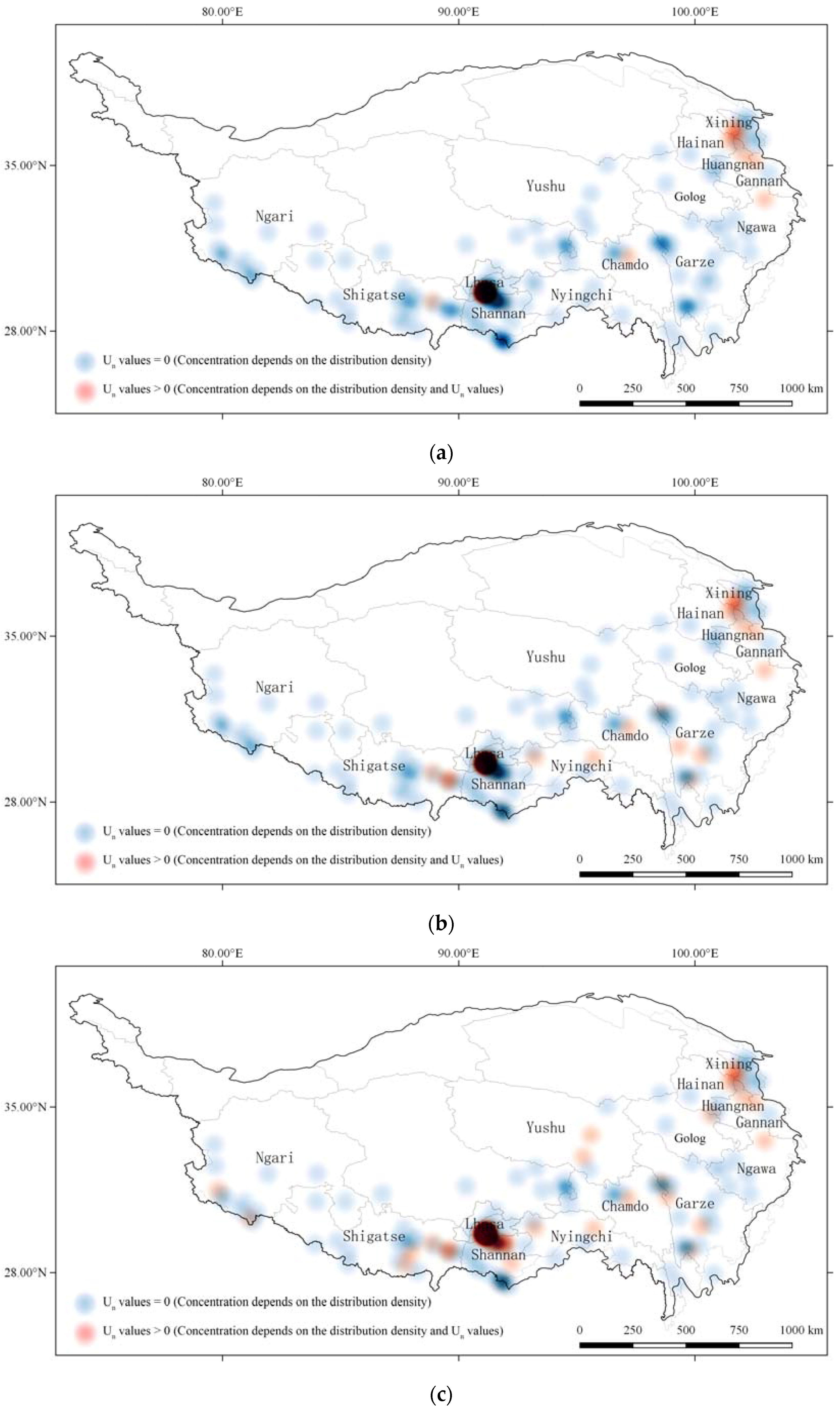
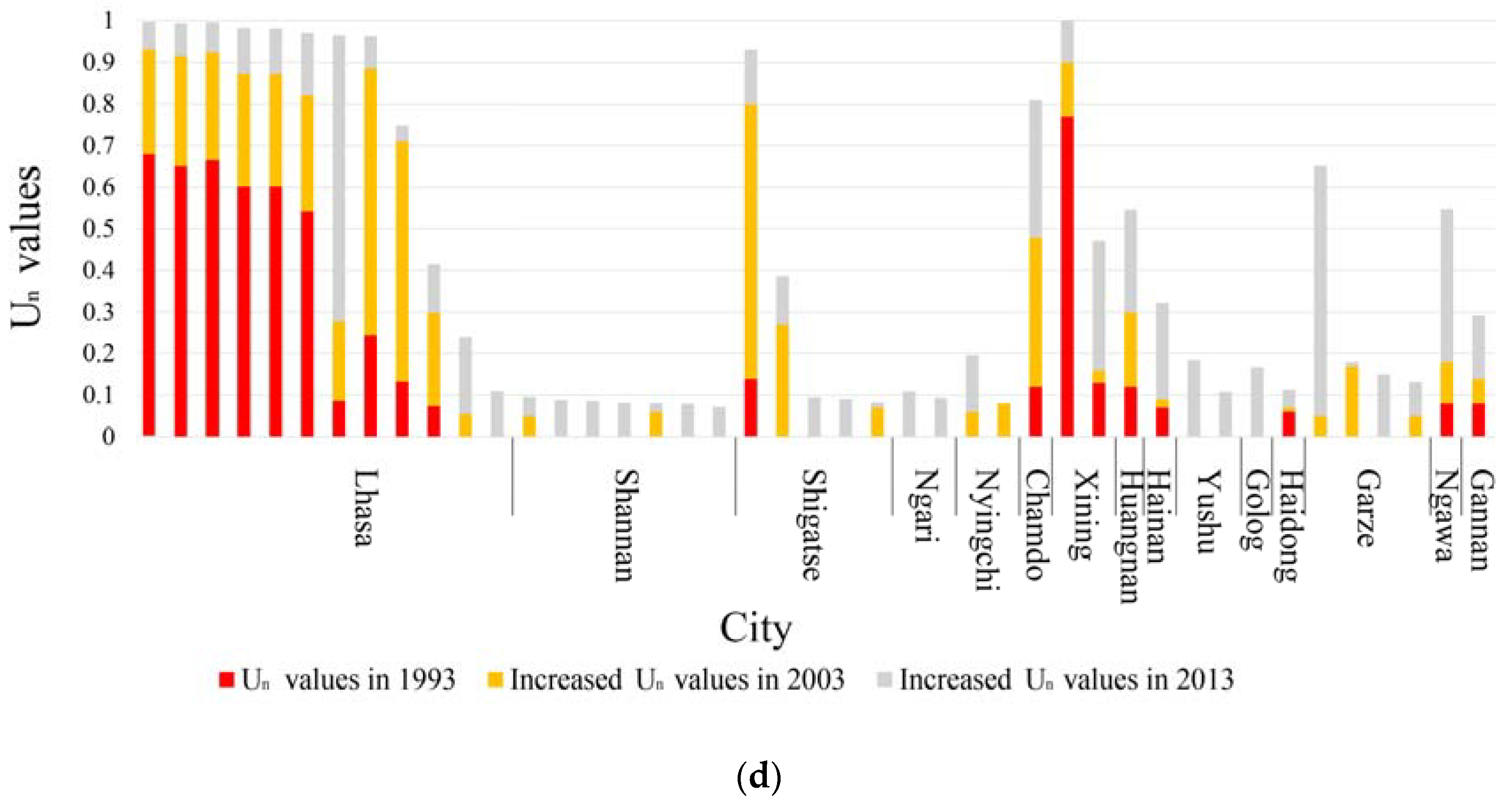
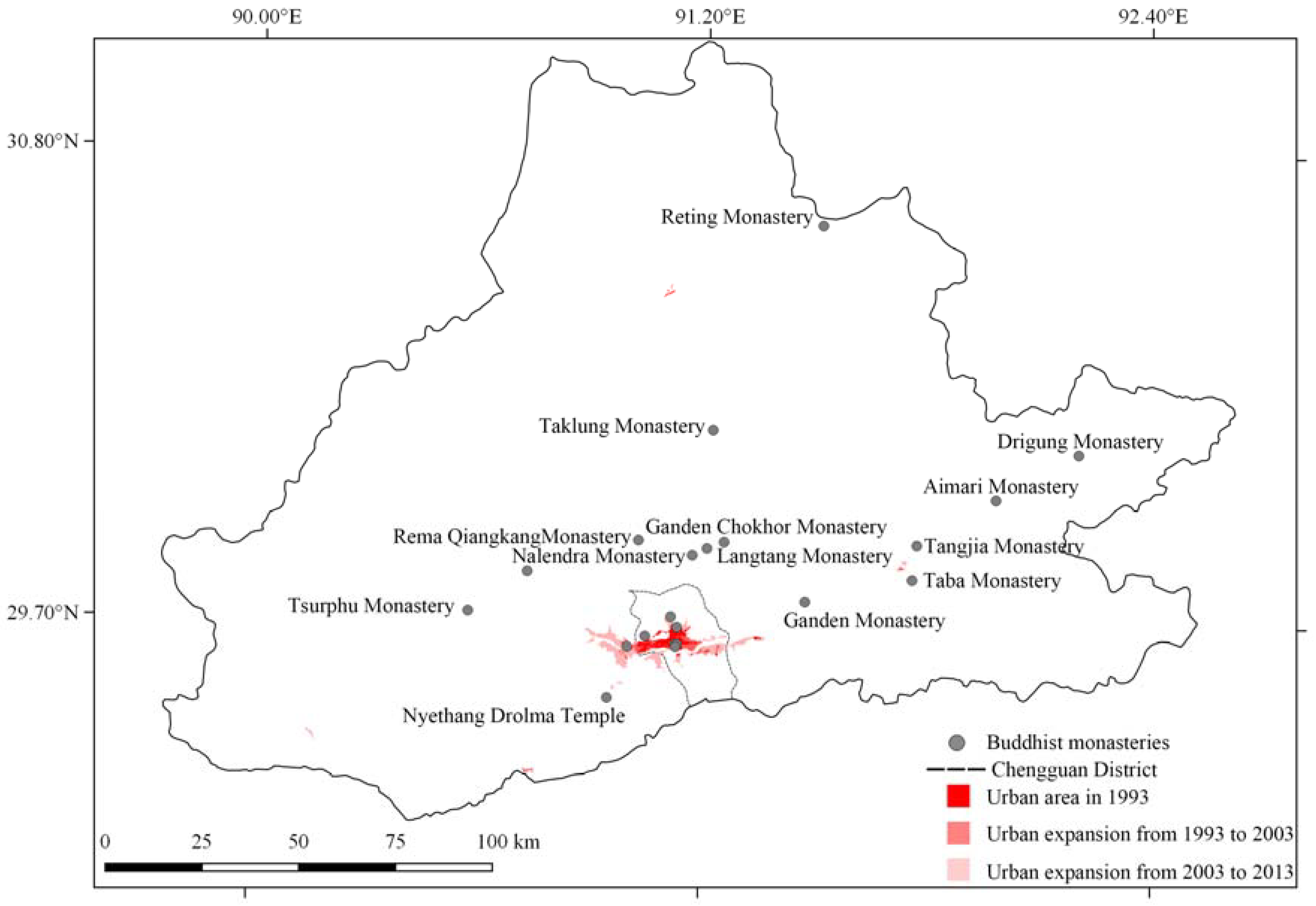



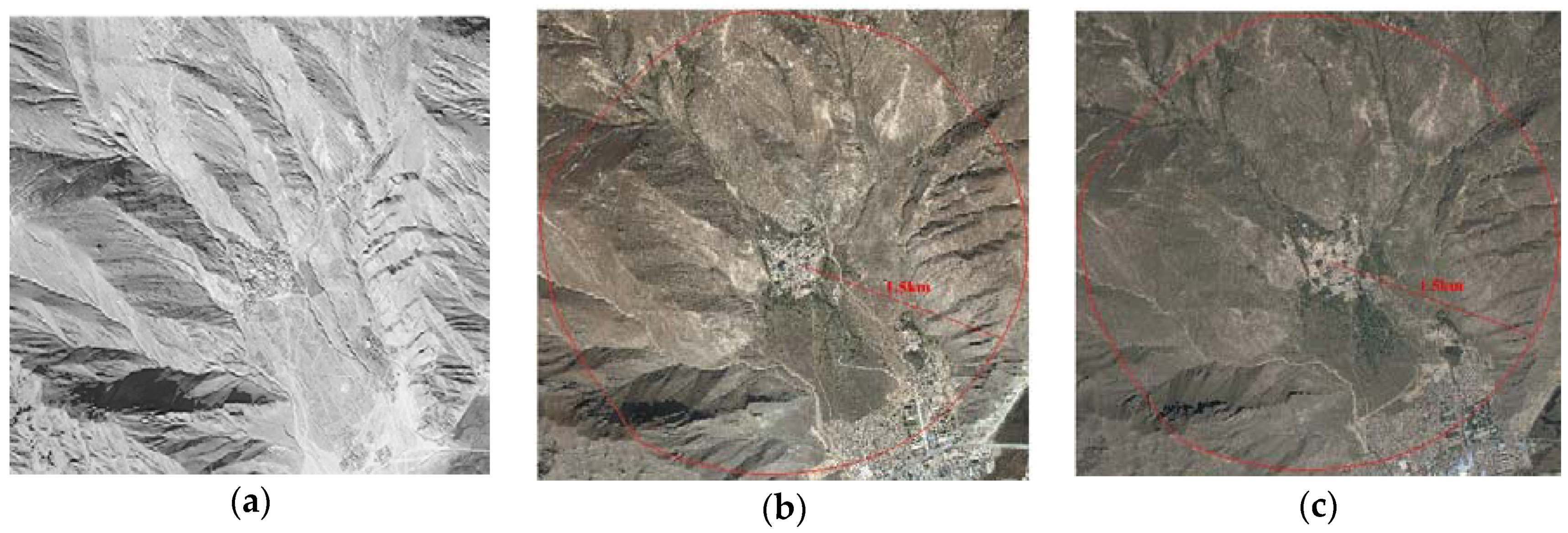


| Number | Satellite | Sensor | Spatial Resolution | Temporal Coverage |
|---|---|---|---|---|
| 1 | DMSP | OLS | 1 km | 1993, 2003, and 2013 |
| 2 | Landsat 5 | TM | 30 m | October 1993 |
| 3 | Landsat 5 | TM | 30 m | November 2003 |
| 4 | Landsat 8 | OLI | 30 m | November 2013 |
| Year | Kappa Coefficient | Overall Accuracy (Percent) |
|---|---|---|
| 1993 | 0.82 | 95.94 |
| 2003 | 0.94 | 97.92 |
| 2013 | 0.98 | 99.26 |
© 2018 by the authors. Licensee MDPI, Basel, Switzerland. This article is an open access article distributed under the terms and conditions of the Creative Commons Attribution (CC BY) license (http://creativecommons.org/licenses/by/4.0/).
Share and Cite
Zhang, Y.; Zhang, H.; Sun, Z. Effects of Urban Growth on Architectural Heritage: The Case of Buddhist Monasteries in the Qinghai-Tibet Plateau. Sustainability 2018, 10, 1593. https://doi.org/10.3390/su10051593
Zhang Y, Zhang H, Sun Z. Effects of Urban Growth on Architectural Heritage: The Case of Buddhist Monasteries in the Qinghai-Tibet Plateau. Sustainability. 2018; 10(5):1593. https://doi.org/10.3390/su10051593
Chicago/Turabian StyleZhang, Yingying, Hong Zhang, and Zheng Sun. 2018. "Effects of Urban Growth on Architectural Heritage: The Case of Buddhist Monasteries in the Qinghai-Tibet Plateau" Sustainability 10, no. 5: 1593. https://doi.org/10.3390/su10051593




